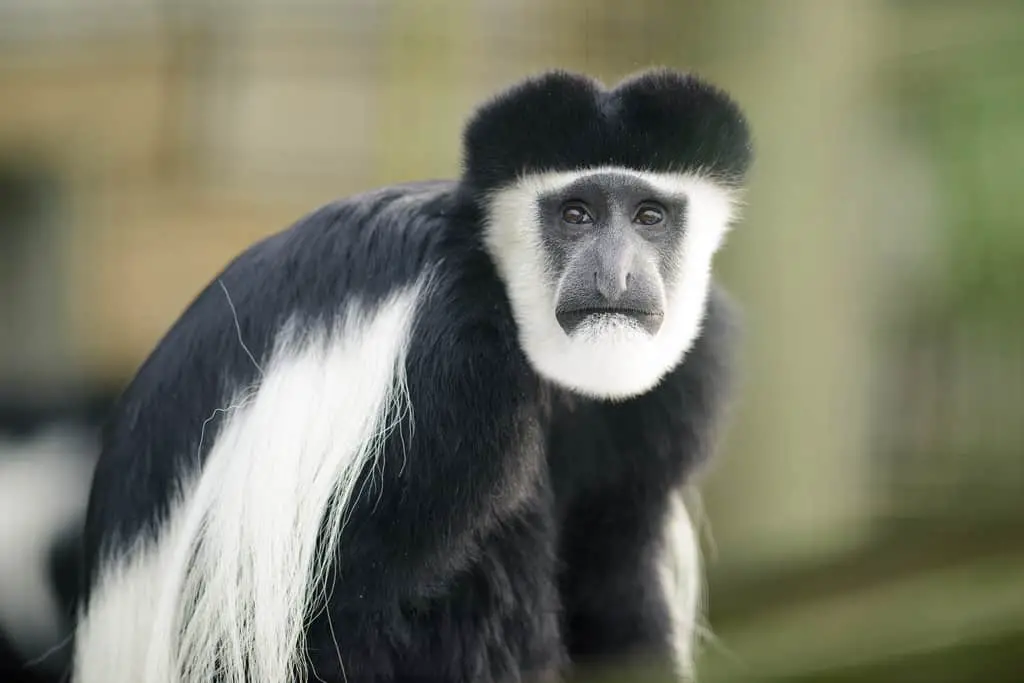Table of Contents
*This post may contain affiliate links. As an Amazon Associate we earn from qualifying purchases.
The colobus monkey is one of the most striking species of monkeys. It is best known for its unique coloring and lack of thumbs. These Old World monkeys are easy to spot once you know what you are looking for. Learn more about the colobus monkey, including its conservation status, with this guide.
When it comes to monkeys, there are Old World and New World monkeys. You can find Old World monkeys predominantly in Africa and Asia. While they may have long tails, the species of Old World monkey are diverse. You can find them in tropical forests, mountains, grasslands, and spread everywhere throughout Asia and Africa. In addition, they have a variety of habits, habitats and characteristics.
The main differences between Old and New World monkeys are that Old World varieties have downturned nostrils and do not have prehensile tails. What does this have to do with the colobus monkey? Well, the colobus monkey is one of many recognizable Old World monkeys. Of all the monkeys, this species stands out for a variety of reasons. This guide will help you discover all you needed to know about the colobus monkey.
What Is the Colobus Monkey?
The Colobus monkey is named for the Greek word kolobus, which means maimed. The reason behind it is that they lack thumbs. This does not put them at any sort of disadvantage, however. Colobus monkeys are great leapers, living most of their lives from tree to tree. There are three genera of colobus distinguished by their coloring. Black and white colobus, red colobus and olive colobus then have several species in their categories.
The differences in each species tend to revolve around size and behavior. The black and white colobus is among the more popular, whereas the red colobus is rare and predominantly in East Africa.

Colobus Monkeys and Their Importance to the Ecosystem
If you know anything about the ecosystem, then you probably know that it can be a fragile balance. Every creature and every plant has an important role to play. Evolution depends on a healthy ecosystem. When you take a species completely out of an ecosystem or, conversely, introduce a new one, you can completely change the state of the ecosystem. Here are a few ways the ecosystem is altered by changing species:
- New predators eradicating old species
- Animals devouring more resources
- An overpopulation of vegetation or insects
Each of these problems can lead to outstanding consequences. Therefore, in saying that, every animal that is naturally a part of its ecosystem has a role to play. The colobus monkey is no different. The colobus monkey isn’t a natural predator. It is smaller, nonaggressive, and tends to feed off leaves and vegetation. Due to this, it tends to make prey for carnivores.
These monkeys aren’t high maintenance and do not need a lot of food to keep themselves alive. Given the small amounts that they eat, they aren’t considered a threat to the forests or vegetation. In fact, they are a healthy part of tree growth. They spend a lot of their time in the tops of trees, feeding off of leaves. This grooming of trees can actually facilitate tree growth. This is important because the colobus monkey isn’t the only animal that relies on these trees for food and shelter.
Keep in mind that the ecosystem balances itself very carefully on the backs of every creature that lives within it. There is a natural harmony amongst animals and when this is shaken up, it can lead to dire consequences. Every animal affects another, either directly or indirectly. This doesn’t only impact animals, however. Humans also rely on the ecosystem. Even if it does not always seem to affect our day-to-day life, it does. So, it’s important for us to care about the life and health of the ecosystem, including the lives of colobus monkeys.
What To Know About the Colobus Monkey
The colobus monkey is among the most interesting species of monkeys. With their beautiful coats and lack of thumbs, they tend to gather a lot of interest from people. Here is some of what you should know about their appearance and behaviors.
Physical Appearance
Once you know what a colobus monkey looks like, their characteristics stand out among other monkeys. While all of them have a similar look, the genera are separated by color. If you are like most, when you hear about colobus monkeys, you will probably picture the black and white variation first. This is the most common and well known. However, there are still two other colorings to be aware of.
Black and White Colobus

While born with white fur, the colobus eventually has mostly black fur with the exception of long white fur descending from its shoulders to wrap around its back. In addition, white fur frames its face, and it has a long white tail. These monkeys are between one and a half and two and a half feet in length. Their tail, on the other hand, is usually about three feet.
Red Colobus

The red colobus comes in shades of brown or black with red markings. The coloring of the red colobus is a little harder to pin down. They come in a variety of colorings. They may be black with red limbs and faces or red with black fur along their heads and upper backs. This particular species is about one and a half feet long.
Olive Colobus

Of all of the colobus monkeys, this one is the smallest. Unfortunately, less is documented about the olive colobus because of its coloring that helps it blend into the vegetation and its shy nature. They are a greenish-brown in color with a yellowish root. Usually, their underside is lighter in color, and the fur around their faces is dark.
Behavior
In addition to physical looks, not every colobus monkey is the same. You can expect a few different details from each species. One of these is that they all live off vegetation. This ranges from leaves, plants and fruits. They have a digestive system that requires them to live solely off plant life.
While many of their lives are similar, there is some variety from species to species. We will provide an overview of their characteristics and behavior.
Black and White Colobus
The black and white colobus leap great distances between trees and branches. While they tend to stay in the trees, they do sometimes drop to the ground for water and other types of food. Mostly they live their lives in the canopies of trees. There are some differences among species. While some colobus monkeys such as the guerezas have eight to 15 members in a group, king colobuses may only have three to four females and one to three males.
Red Colobus
The red colobuses tend to be more aggressive than the other species. They have a dominance hierarchy, where higher-ranked monkeys receive food, grooming and mating partners first. They can live in groups of up to 80 monkeys. However, on average, they tend to have troops of 20 to 40. When it comes to other troops, some female monkeys will travel between troops together. Most of the time, different groups react passively to one another, but they can sometimes be tense or violent. An interesting fact about the red colobus is that as adolescents, they tend to get restless and search for a new troop. Since some troops do not like newcomers, the monkeys will spy on the troops from a close-by monkey troop before they decide to join.
Olive Colobus
The olive colobus is shy and difficult for people to observe in the wild. They tend to have a complex social structure, with several breeding males, females and their infants all in the same group. While they stick to their species, you can also find olive colobus associating with the Diana monkey. Unlike some species, there is no male monopolization present with them.
While there are plenty of different types of colobus, one thing is for sure: These are social primates, much like the rest. They travel in groups, live off vegetation, and while they do show signs of aggression amongst each other and toward other animals, they are not particularly aggressive or violent. Most signs of violence come when one group is supplanting another.
How To Help the Colobus Monkey
Is the colobus monkey threatened? The answer to this is, sadly, yes. While the colobus monkey is not on the endangered species list, they do have their share of human threats. Deforestation is spreading at a rapid rate, and this affects the colobus monkey directly. Without a habitat to live in, they do not stand much of a chance. Additionally, the species like the red colobus do not live long in captivity.
When it comes to deforestation, this is something that directly threatens each species. It’s not the only thing, however. The black and white colobus monkey, particularly, is desirable due to its fur. Given their importance to our ecosystem, it is important for us to pay attention to these creatures, to make sure that they remain alive and that their habitats stay intact. One of the best ways for people to help is to get involved with organizations that want to preserve habitat through either volunteer work or donations.

